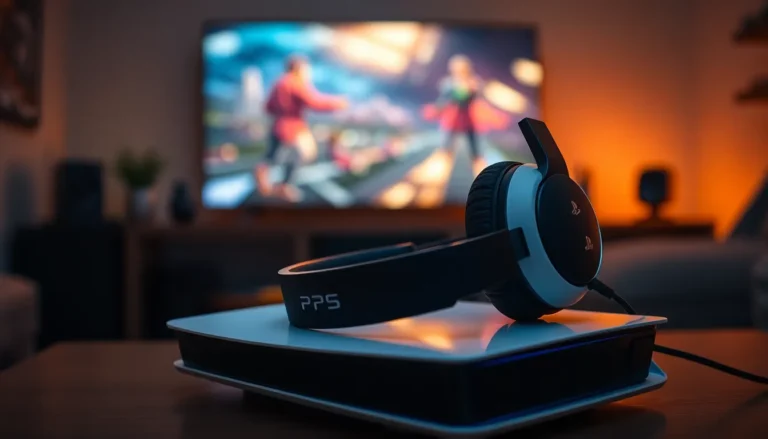Table of Contents
ToggleWhen victory dances hang in the balance, few things are as frustrating as Fortnite FPS drops. Picture this: you’re about to unleash a legendary headshot, and suddenly the game stutters like it’s trying to remember the lyrics to a song. It’s enough to make even the calmest player scream into their headset.
Overview of Fortnite FPS Drops
Fortnite FPS drops occur when the game’s frame rate decreases significantly, impacting both gameplay and player performance. Players often face this issue during critical moments, such as intense battles or building scenarios. These drops can lead to missed shots or poor execution of strategies, causing frustration and negative experiences.
Several factors contribute to FPS drops in Fortnite. Hardware limitations present a common cause, where older gaming consoles or PCs struggle to run the game optimally. Settings that exceed the device’s capabilities can also create strain, resulting in lag. Additionally, background applications may consume system resources, further affecting performance.
Network issues frequently cause latency, manifesting as lag or FPS drops. Poor internet connections can disrupt data transmission, causing delays between player actions and game responses. Server issues, such as high latency or downtime, contribute to decreased performance as well.
Optimizing settings can mitigate FPS drops. Adjusting graphics settings to lower levels helps to alleviate the workload on the hardware. Closing background applications can free up resources, enhancing overall system performance.
Monitoring temperatures is vital as overheating components can throttle system performance. Users should ensure proper ventilation for their gaming systems. Regular updates to both Fortnite and hardware drivers keep the system optimized, often reducing performance issues.
Fortnite players experiencing FPS drops should assess all aspects of their gaming setup. Identifying and addressing hardware limitations, optimizing settings, and ensuring stable internet connections can significantly improve performance during crucial gameplay moments.
Common Causes of FPS Drops
FPS drops in Fortnite can stem from various technical issues, heavily impacting gameplay. Identifying the root causes helps players optimize performance during critical moments.
Hardware Limitations
Limited hardware capabilities frequently cause FPS drops. Low-end graphics cards struggle with rendering high-quality graphics, resulting in lag. Insufficient RAM can also hinder performance, especially when running demanding applications simultaneously. Older processors may experience difficulty handling the game’s intricate mechanics and rapid movements. Players using systems that barely meet Fortnite’s recommended specifications often encounter these performance issues. Upgrading components like the graphics card, RAM, or CPU can significantly enhance overall gameplay.
Software Issues
Software-related problems often lead to FPS drops. Outdated drivers frequently cause compatibility issues with the game. Background applications consuming resources can severely impact performance, leading to stuttering and lag. Malware or unwanted software, when present, can further disrupt the gaming experience. Players should regularly update their operating systems and ensure unnecessary applications are closed before launching Fortnite. Using the game’s built-in performance analysis tools helps diagnose and address software-related performance problems effectively.
How to Diagnose FPS Drops
Diagnosing FPS drops in Fortnite requires attention to various factors. Players should start by reviewing their in-game settings.
In-Game Settings
Adjusting in-game settings can significantly impact FPS. Lowering the resolution and turning off shadows often improves frame rates. Increasing view distance may enhance visual clarity while maintaining performance. Reducing textures and disabling post-processing can also relieve strain on the system. Players should experiment with different configurations to find the optimal balance between visuals and performance. Utilizing the “Performance Mode” setting is recommended, especially on lower-end systems. This mode optimizes gameplay without sacrificing too much graphical quality, making it easier to maintain higher FPS.
Performance Monitoring Tools
Performance monitoring tools help players identify the underlying causes of FPS drops. Software applications like MSI Afterburner and FRAPS provide real-time statistics on frame rates and system metrics. Observing these metrics allows users to pinpoint issues related to CPU and GPU usage. Resource monitoring also uncovers potential heat issues or throttling that might occur. Task Manager is another handy tool, as it shows which background applications consume resources. Frequent use of these tools helps players make informed adjustments to enhance performance and enjoy a smoother gaming experience.
Solutions to Improve FPS
Addressing FPS drops in Fortnite can enhance the gaming experience significantly. Players can apply various optimization techniques to restore frame rates during intense moments.
Graphics Settings Optimization
Adjusting graphics settings provides immediate benefits for frame rates. Lowering the resolution reduces the amount of graphical data the system processes at once. Turning off shadows also improves performance, as these effects can be demanding on hardware. Furthermore, enabling “Performance Mode” simplifies the visuals, promoting smoother gameplay without sacrificing essential details in action. Experimenting with these settings helps players find the right balance that suits their hardware capabilities.
System Updates and Drivers
Keeping the system updated is crucial for maintaining optimal performance. Regularly installing operating system updates ensures compatibility with the latest game patches. Updating graphics drivers accesses enhancements that improve how a graphic card processes data. Outdated drivers often contribute to performance issues, so checking for updates frequently can prevent lapses during gameplay. Closing background applications also frees up resources, allowing the game to use more of the available CPU and RAM for smooth operation.
Conclusion
Experiencing FPS drops in Fortnite can be a major hurdle for players striving for peak performance. By understanding the various factors that contribute to these drops and implementing effective solutions, gamers can enhance their overall experience. Optimizing graphics settings and ensuring hardware is up to date are essential steps in minimizing disruptions during gameplay.
Regular maintenance of both software and system resources can lead to smoother sessions and improved responsiveness. With the right adjustments and proactive monitoring, players can enjoy a more fluid and engaging Fortnite experience, allowing them to focus on what truly matters—dominating the competition.






